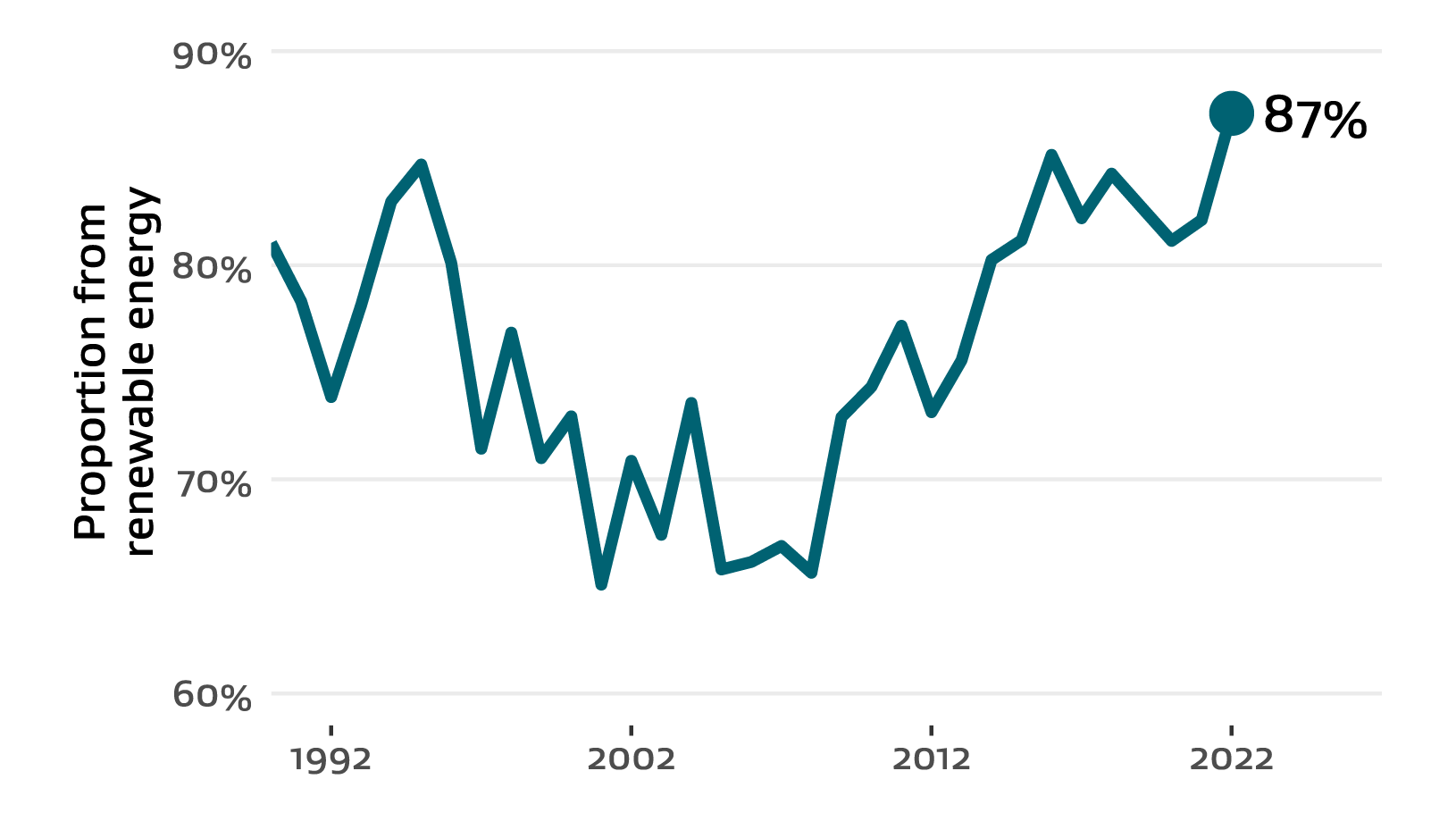
In 2022, New Zealand made significant strides in its renewable energy sector, with a record-high share of energy coming from sustainable sources. The country’s commitment to clean energy was evident across various sectors, particularly in electricity generation.
According to the Ministry of Business, Innovation and Employment’s (MBIE) annual report, Energy in New Zealand 2023, renewable electricity generation reached an impressive 87% in 2022, a notable increase from previous years. This achievement underscores New Zealand’s progress towards its goal of 90% renewable electricity by 2025, as announced by former Prime Minister Helen Clark in 2007.
Hydropower played a crucial role in this renewable energy mix, contributing significantly to the country’s electricity generation. In 2022, hydro generation accounted for 60% of all electricity, a 4.4 percentage point increase from 2021. This surge was attributed to high rainfall that replenished New Zealand’s hydro lakes during the winter months, highlighting the importance of favourable weather conditions for hydroelectric power production.
Wind energy has been identified as a key component in New Zealand’s renewable energy future. While specific figures for wind energy in 2022 were not provided in the search results, it’s worth noting that wind power is expected to make up a significant portion of the increase needed to reach the 90% renewable electricity target.
Solar power, although not as prominent as hydro or wind in New Zealand’s energy mix, has been gaining traction. The technology became more affordable in the mid-2010s, leading to a steady increase in uptake in both residential and commercial markets. While large-scale solar generation plants are not yet common in New Zealand, the recent changes in pricing may pave the way for their development in the future.
The overall share of energy supply from renewables reached 44% in 2022, building on the previous year’s record high of 40.8%. This marks the highest level since reporting began in 1990, demonstrating New Zealand’s consistent progress in sustainable energy adoption.
It’s important to note that New Zealand’s success in renewable energy extends beyond electricity generation. The country achieved a new record in renewable energy consumption, with 30% of total final energy consumption coming from renewable sources in 2022.
As New Zealand continues to advance its sustainable energy goals, the country faces challenges in adapting its electricity system to accommodate greater shares of variable renewables like wind and solar. Additionally, given the heavy reliance on hydropower, preparing for potential lower-than-expected output during dry periods remains a crucial consideration for maintaining energy security.
In conclusion, New Zealand’s sustainable energy sector showed remarkable progress in 2022, with hydropower leading the way and promising developments in wind and solar energy. The country’s commitment to renewable energy sources positions it as a potential global leader in integrating high shares of renewables while maintaining energy security.
Electricity | Ministry of Business, Innovation & Employment Image

More on our renewable energy packages for small businesses and homes that combine solar, wind, and small turbines. These hybrid solutions are becoming increasingly popular and efficient for providing sustainable energy.
A comprehensive package for small businesses and homes could include:
Solar PV System:
Solar panels would form the primary component of the package, providing energy during daylight hours. We offer high-efficiency solar panels with impressive output and long warranties. These panels can be roof-mounted or ground-mounted, depending on the available space.
Small Wind Turbine:
To complement solar energy and provide power when the sun isn’t shining, a small wind turbine can be included. We offer advanced small-wind turbine technology.
Battery Storage:
A crucial component of any off-grid or hybrid system is battery storage and we offer the PowerPak system with LiFePo4 battery technology, ensuring 80% retention capacity after 10 years.
Hybrid Inverter:
A smart inverter system would manage the power flow between solar panels, wind turbines, batteries, and the grid (if grid-connected).
Optional Backup Generator:
For additional security, especially in off-grid scenarios, a backup generator can be included. We partner with local power equipment to offer this option.
Energy Management System:
An intelligent control system to optimize energy production, storage, and consumption across all components.
This type of package offers several benefits:
Diversified Energy Sources:
Combining wind and solar provides more consistent energy production across various weather conditions and times of day.
Increased Self-Sufficiency:
Reduces reliance on the grid, potentially leading to lower electricity costs.
Environmental Impact:
Generates clean, renewable energy without greenhouse gas emissions.
Scalability:
Systems can be designed to meet specific energy needs, from small homes to larger businesses.
Potential for Energy Export:
Excess energy can often be sold back to the grid, providing additional income.
We specialize in creating personal packages tailored specifically for small business & residential properties. When considering such a package, it’s important to assess factors like local wind conditions, available space, energy consumption patterns, and budget. Many providers offer consultation services to help determine the optimal system configuration for specific needs.